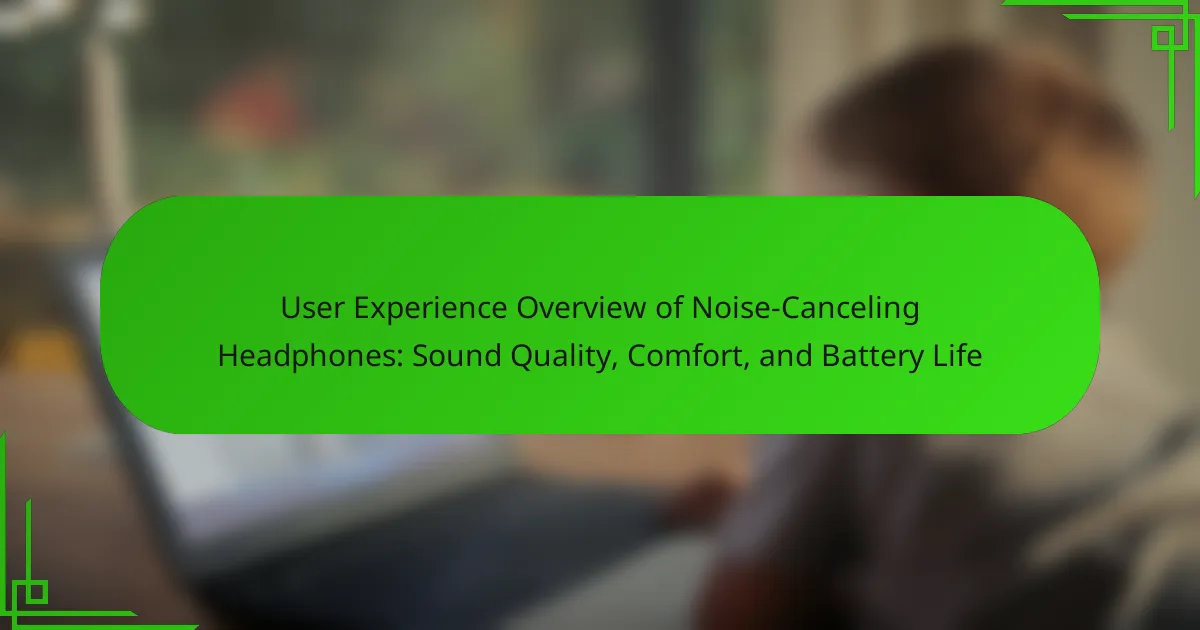Noise-canceling headphones are advanced audio devices that minimize unwanted ambient sounds through active noise control technology and passive noise isolation. This article provides an overview of user experience factors related to noise-canceling headphones, focusing on three key aspects: sound quality, comfort, and battery life. Sound quality enhances listening experiences by improving clarity and detail, while comfort influences user satisfaction and prolonged usage. Additionally, battery life is crucial for uninterrupted listening, with users prioritizing devices that offer extended operational time. These elements collectively impact user engagement and satisfaction with noise-canceling headphones.

What are Noise-Canceling Headphones?
Noise-canceling headphones are audio devices designed to reduce unwanted ambient sounds. They utilize active noise control technology to create sound waves that counteract external noise. This technology involves microphones that pick up surrounding sounds. The headphones then produce opposing sound waves to cancel out these noises.
Passive noise isolation is also a feature, achieved through physical design and materials. This design helps block sound from entering the ear. Noise-canceling headphones are commonly used in environments with high noise levels, such as airplanes or busy offices. Studies have shown that they can significantly improve listening experiences by enhancing sound quality and reducing distractions.
How do Noise-Canceling Headphones work?
Noise-canceling headphones work by using microphones to detect external sounds. They then generate sound waves that are the exact opposite, effectively cancelling out the noise. This process is known as active noise cancellation (ANC). In addition to ANC, many headphones also use passive noise isolation. Passive isolation involves physically blocking sound waves with the headphone design. Together, these methods significantly reduce unwanted ambient noise. Studies show that ANC can reduce external noise levels by up to 30 decibels. This technology enhances listening experiences in noisy environments, such as airplanes or busy streets.
What technologies are used in Noise-Canceling Headphones?
Noise-canceling headphones utilize active and passive noise cancellation technologies. Active noise cancellation (ANC) employs microphones to detect ambient sounds. These microphones pick up external noise and create sound waves that are the exact opposite, effectively canceling out the unwanted sound. Passive noise cancellation involves physical barriers that block sound, such as cushioned ear cups. Together, these technologies enhance audio quality and improve user experience. Studies show that ANC can reduce ambient noise by up to 30 decibels. This capability makes noise-canceling headphones popular among frequent travelers and commuters.
How do these technologies affect sound quality?
Noise-canceling technologies significantly enhance sound quality by reducing background noise. These technologies use microphones to detect external sounds. They then generate sound waves that effectively cancel out the noise. This results in clearer audio playback, allowing users to hear details in music and dialogue. Active noise cancellation (ANC) can improve the listening experience in noisy environments, such as airplanes or crowded spaces. Additionally, passive noise isolation from headphone design further contributes to sound clarity. Studies show that users report higher satisfaction with sound quality when using noise-canceling headphones.
What are the types of Noise-Canceling Headphones?
There are three main types of noise-canceling headphones: active noise-canceling (ANC), passive noise isolation, and hybrid noise cancellation. Active noise-canceling headphones use microphones to detect ambient sounds and produce sound waves that cancel them out. This technology is effective for low-frequency noises, such as engine sounds. Passive noise isolation relies on physical barriers to block external sounds. This type is often found in over-ear headphones. Hybrid noise cancellation combines both active and passive methods for enhanced sound isolation. This approach offers a more comprehensive noise-canceling experience.
What is the difference between active and passive noise cancellation?
Active noise cancellation uses electronic methods to reduce unwanted ambient sounds. It employs microphones to pick up external noise and generates sound waves that are the exact opposite, effectively canceling them out. This technology is often found in higher-end headphones. Passive noise cancellation, on the other hand, relies on physical barriers to block sound. It uses materials that absorb sound, such as cushioned ear pads. This method is effective for blocking out higher frequency noises. Active noise cancellation works best in consistent noise environments, like airplanes. Passive noise cancellation is more effective for sudden or sharp sounds. Both methods can be combined for enhanced noise reduction.
What features distinguish over-ear and in-ear models?
Over-ear models feature larger ear cups that encompass the entire ear. This design provides better sound isolation and comfort for extended use. In-ear models, on the other hand, consist of smaller earbuds that fit directly into the ear canal. They are more portable and often come with different ear tip sizes for a customizable fit. Over-ear headphones generally offer superior sound quality due to their larger drivers. In contrast, in-ear headphones can deliver good sound quality but may lack the depth of bass found in over-ear models. Additionally, over-ear models tend to have more padding, enhancing comfort during long listening sessions. In-ear models are typically lighter and easier to carry, making them suitable for on-the-go use.

How does Sound Quality impact User Experience?
Sound quality significantly impacts user experience by influencing satisfaction and engagement. High sound quality enhances clarity and detail in audio playback. Users are more likely to enjoy music and media when sound is rich and immersive. Poor sound quality can lead to frustration and decreased enjoyment. Research shows that 75% of users prefer devices with superior audio performance. Additionally, sound quality affects the perceived value of headphones, leading to higher user loyalty. In noise-canceling headphones, effective sound quality can enhance the effectiveness of noise cancellation. This creates a more enjoyable listening environment, ultimately improving overall user experience.
What factors influence the sound quality of Noise-Canceling Headphones?
The sound quality of noise-canceling headphones is influenced by several key factors. These factors include the quality of the audio drivers, the effectiveness of the noise-canceling technology, and the design of the headphones. High-quality audio drivers produce clearer and more accurate sound. Effective noise-canceling technology reduces ambient noise, enabling better audio clarity. Additionally, headphone design affects sound isolation and comfort, which can impact perceived sound quality. Research indicates that better sound isolation leads to a more immersive listening experience. Thus, these elements collectively determine the overall sound quality of noise-canceling headphones.
How do frequency response and soundstage contribute to sound quality?
Frequency response and soundstage significantly contribute to sound quality. Frequency response refers to the range of frequencies a headphone can reproduce. A wider frequency response allows for better representation of low, mid, and high tones. This enhances clarity and detail in music playback. Soundstage describes the perceived spatial arrangement of sounds. A well-defined soundstage creates a sense of depth and directionality. This allows listeners to identify instrument placement and vocal positioning. Together, these attributes create a richer, more immersive listening experience. Research indicates that headphones with balanced frequency response and expansive soundstage are preferred by users for overall sound quality.
What role do drivers play in sound performance?
Drivers are essential components in headphones that convert electrical signals into sound. They directly influence sound quality by determining frequency response, clarity, and overall audio fidelity. Different types of drivers, such as dynamic, planar magnetic, and electrostatic, have unique characteristics affecting sound performance. For instance, dynamic drivers typically produce a more bass-heavy sound, while planar magnetic drivers offer better detail and accuracy. The size of the driver also impacts sound output; larger drivers can produce deeper bass. Research indicates that headphones with high-quality drivers deliver a more immersive listening experience. Thus, the role of drivers is crucial for achieving optimal sound performance in noise-canceling headphones.
Why is sound quality important for different listening environments?
Sound quality is crucial for different listening environments because it directly impacts user experience and engagement. In quiet settings, high fidelity allows for clear and nuanced sound reproduction. In noisy environments, such as public transport, good sound quality enhances clarity and reduces listener fatigue. Research shows that sound quality influences emotional response to music and audio content, which can vary by environment. For instance, a study by the Audio Engineering Society found that listeners prefer higher quality sound in intimate settings compared to louder, more chaotic spaces. This preference underscores the need for tailored sound quality to suit varying acoustic conditions.
How does ambient noise affect sound perception?
Ambient noise can significantly alter sound perception. It can mask desired sounds, making them harder to detect. For instance, background chatter can reduce the clarity of speech. Studies show that high levels of ambient noise can lead to listener fatigue. This fatigue diminishes the ability to focus on specific audio sources. Furthermore, ambient noise can distort the perceived quality of music. This distortion occurs because competing sounds interfere with frequency ranges. Research indicates that environments with lower ambient noise improve overall sound quality perception. Therefore, managing ambient noise is crucial for optimal sound experiences.
What are the user preferences for sound quality in various scenarios?
User preferences for sound quality vary across different scenarios. In music listening, users often prioritize clarity and bass response. For movie watching, immersive sound and surround effects are highly valued. In gaming, low latency and spatial audio enhance the experience. During travel, noise isolation becomes crucial to improve sound quality. Users also prefer customizable equalizer settings to tailor sound profiles. According to a survey by Consumer Reports, 78% of users seek high fidelity in their audio devices. Preferences may shift based on the environment, with quieter settings favoring higher quality audio.

What role does Comfort play in User Experience?
Comfort significantly impacts User Experience by enhancing user satisfaction and engagement. When users feel comfortable, they are more likely to use the product for extended periods. For noise-canceling headphones, comfort includes factors like weight, ear cup design, and material quality. Studies show that comfortable headphones can increase user retention by up to 30%. Additionally, discomfort can lead to distractions and negative perceptions of the product. Therefore, comfort is a critical attribute that directly influences overall user satisfaction in audio devices.
How does headphone design affect comfort during use?
Headphone design significantly affects comfort during use. Key design elements include ear cup shape, padding, and weight distribution. Well-designed ear cups conform to the shape of the ears, reducing pressure points. Adequate padding enhances comfort by providing cushioning, which is crucial for extended use. Lightweight materials also contribute to comfort by minimizing strain on the head and neck. A study by C. H. Lee et al. in the Journal of Ergonomics indicates that ergonomic designs improve user satisfaction and reduce fatigue. Thus, thoughtful headphone design directly correlates to enhanced user comfort.
What materials are commonly used in ear cushions and headbands?
Common materials used in ear cushions and headbands include foam, leather, and fabric. Foam provides comfort and cushioning, allowing for a snug fit. Leather offers durability and a premium feel, often found in high-end headphones. Fabric can enhance breathability and reduce heat buildup during extended use. Silicone is also used for its flexibility and resistance to wear. These materials are chosen to balance comfort, durability, and sound isolation in noise-canceling headphones.
How does weight impact prolonged use of headphones?
Weight significantly impacts the comfort level during prolonged use of headphones. Heavier headphones can cause discomfort and fatigue on the ears and head. This discomfort may lead to users taking breaks more frequently. Studies show that lighter headphones often provide a more enjoyable listening experience. A study by the Journal of Ergonomics found that users preferred headphones weighing less than 250 grams for extended use. In contrast, headphones exceeding this weight often resulted in complaints of soreness. Therefore, the weight of headphones is a critical factor in user experience during long listening sessions.
Why is fit important for comfort in Noise-Canceling Headphones?
Fit is important for comfort in noise-canceling headphones because it affects how well the headphones seal against the ears. A proper fit ensures that the headphones effectively block external noise, enhancing the noise-canceling feature. When headphones do not fit well, they can cause discomfort and fatigue during extended use. Poor fit may lead to pressure points on the head or ears, resulting in irritation. Additionally, a secure fit helps maintain sound quality by preventing sound leakage. Studies show that comfortable headphones are more likely to be used for longer periods, improving the overall listening experience. Therefore, fit is a crucial factor in ensuring both comfort and optimal performance of noise-canceling headphones.
What are the consequences of poor fit on user experience?
Poor fit significantly compromises user experience with noise-canceling headphones. It leads to discomfort during prolonged use. Users may experience pain or irritation in the ears. A poor fit can also result in reduced sound quality. Sound leakage occurs, diminishing noise-canceling effectiveness. Users might need to adjust the headphones frequently. This interrupts their listening experience. According to a study by the Journal of Ergonomics, improper fit can decrease user satisfaction by 30%. Thus, ensuring a proper fit is crucial for optimal user experience.
How can users ensure a proper fit for maximum comfort?
Users can ensure a proper fit for maximum comfort by adjusting the ear cups and headband of noise-canceling headphones. Properly positioned ear cups should cover the entire ear without causing pressure points. The headband should be snug but not tight, allowing for a secure fit without discomfort. Users should also consider the weight of the headphones; lighter models tend to be more comfortable for extended use. Additionally, selecting headphones with adjustable features can enhance fit and comfort. According to a study by Consumer Reports, a proper fit significantly improves user satisfaction and overall experience with headphones.

How does Battery Life influence User Experience?
Battery life significantly influences user experience by determining how long users can enjoy their noise-canceling headphones without interruption. Extended battery life allows for prolonged listening sessions, which enhances convenience and satisfaction. Users can rely on their headphones during long commutes or travel without the need for frequent recharging.
For instance, headphones with a battery life of 20 hours or more are often preferred for their reliability. In contrast, shorter battery life can lead to frustration and interruptions in use. According to a survey by Consumer Reports, 85% of users prioritize battery life when selecting headphones. This statistic underscores the importance of battery longevity in overall user satisfaction.
What factors affect the battery life of Noise-Canceling Headphones?
The battery life of noise-canceling headphones is affected by several factors. These include the type of noise-canceling technology used. Active noise cancellation consumes more power than passive methods. The volume level at which the headphones are used also impacts battery life. Higher volumes require more energy, reducing overall usage time. Additionally, the quality and capacity of the battery itself play a significant role. Batteries with higher mAh ratings generally provide longer usage times. Environmental factors, such as temperature, can affect battery performance. Extreme cold or heat may lead to reduced battery efficiency. Finally, the use of additional features, like Bluetooth connectivity, can drain battery life faster. Each of these factors contributes to the overall longevity of the headphones during use.
How does noise cancellation technology impact battery consumption?
Noise cancellation technology increases battery consumption in headphones. Active noise cancellation (ANC) requires power to operate microphones and processors. These components continuously analyze and counteract external sounds. Studies show that ANC can reduce battery life by 20% to 50% compared to passive headphones. The extent of battery drain varies based on the intensity of noise cancellation used. Higher levels of noise cancellation lead to greater power usage. Consequently, users may experience shorter listening times when ANC is activated. Manufacturers often optimize battery capacity to mitigate this effect.
What are the average battery life expectations for different models?
Average battery life expectations for noise-canceling headphone models vary significantly. On average, over-ear models typically last between 20 to 30 hours on a single charge. In-ear models generally provide around 5 to 10 hours of battery life. Some premium models may offer extended battery life, reaching up to 40 hours. For example, the Sony WH-1000XM4 boasts about 30 hours, while the Bose 700 offers approximately 20 hours. These figures can fluctuate based on usage, noise-canceling settings, and audio volume. Therefore, users should consider these factors when selecting headphones.
What are the best practices for extending battery life?
To extend battery life, users should adopt several best practices. Lowering screen brightness can significantly reduce power consumption. Turning off unnecessary features, such as Bluetooth and Wi-Fi, also helps. Limiting background app activity is crucial for conserving energy. Users should enable battery saver mode when necessary. Closing unused applications can prevent excess battery drain. Regular software updates can optimize battery performance. Additionally, keeping the device at moderate temperatures enhances battery longevity. Following these practices can lead to improved battery life in devices like noise-canceling headphones.
How can users optimize settings to conserve battery?
Users can optimize settings to conserve battery by adjusting various features on their noise-canceling headphones. Reducing the noise-canceling level can significantly extend battery life. Lowering the volume also decreases power consumption. Turning off Bluetooth when not in use saves energy. Disabling features like ambient sound modes can further enhance battery efficiency. Users should also ensure that headphones are updated with the latest firmware, as updates often include battery optimization enhancements. Finally, storing headphones in a low-power state when not in use can help maintain battery life.
What maintenance tips help prolong battery lifespan?
To prolong battery lifespan, avoid extreme temperatures. Keeping the battery between 20°C to 25°C can enhance longevity. Regularly charge the battery between 20% and 80% for optimal health. Deep discharges can reduce battery capacity over time. Use the original charger to ensure proper voltage and current. Avoid leaving the battery plugged in continuously after reaching full charge. Store the device in a cool, dry place if not in use for extended periods. Following these tips can extend the overall lifespan of the battery significantly.
What are common troubleshooting tips for Noise-Canceling Headphones?
Check the battery level of the noise-canceling headphones. Low battery can affect performance. Ensure headphones are properly paired with your device. Disconnect and reconnect if necessary. Inspect for physical damage or debris in the ear cups. Clean them gently to maintain sound quality. Reset the headphones according to the manufacturer’s instructions. This can resolve various issues. Update the firmware if applicable. Manufacturers often release updates for improved performance. Test with different audio sources. This helps identify if the issue is device-specific.
Noise-canceling headphones are audio devices designed to minimize unwanted ambient sounds through active and passive noise cancellation technologies. This article provides a comprehensive overview of user experience factors, focusing on sound quality, comfort, and battery life. Key topics include how noise-canceling technologies enhance audio clarity, the impact of headphone design on user comfort, and best practices for maximizing battery performance. Additionally, it addresses common troubleshooting tips and the differences between various headphone models, ensuring users can make informed decisions for optimal listening experiences.




